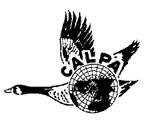Canadian Air Line Pilots Association (CALPA)

"The Canadian Air Line Pilots Association has made unique contributions to the advancement of Canadian and international air transport, over a span of half a century."
CALPA was formed on December 1, 1937, to consolidate airline pilots' views regarding aviation concerns, with the authority to voice them when necessary.
In 1943, on the initiative of CALPA, an agreement of affiliation was signed between the Canadian, British and American Air Line Pilots Associations to promote the orderly development of international civil aviation. This affiliation was the fore-runner of the International Federation of Air Line Pilots Association (IFALPA), co-founded by CALPA in 1948. At that time, IFALPA represented the pilots of 65 nations, with CALPA as its second largest member. The Federation's mandate is to consolidate the opinion of its members on a wide variety of topics that concern aviation technology and safety, and present these to the International Civil Aviation Organization (ICAO), the International Air Transport Association (IATA), Interpol, and governments.
A very important division of CALPA worked in the technical and air safety field. Several committees at the local and executive council levels dealt with safety concerns and accident investigation. In 1956 CALPA's Safety Chairman and a Trans-Canada Airlines engineer graduated from the Accident Investigation course at the University of Southern California. They became the first trained accident investigators in Canada.
In 1979 the Dubin Commission was formed to inquire into aviation safety in Canada. CALPA was represented throughout, and the inquiry required major effort from CALPA's Technical and Air Safety Division, which presented 22 witnesses and seven complete briefs during the 116 days of hearings. CALPA had great influence on the many benefits to aviation that resulted from the Dubin hearings, such as the creation of the Canadian Aviation Safety Board, the independent accident investigation agency whose establishment CALPA had long been promoting.
CALPA worked tirelessly for four years to persuade the Canadian government to ratify The Hague and Montreal Conventions against hijacking. Thus security was enhanced at Canadian airports.
CALPA's Aeromedical Committee worked for many years to obtain a more enlightened attitude by the airlines and the authorities toward pilot medical fitness. As a result of the work of this committee, many highly trained pilots have been retained and have been able to continue their chosen profession.
CALPA has influenced the development of air transportation in Canada in a number of other ways. It has had impact on development of procedures for fire fighting, rescue work, and airport disaster planning. It has been active in the study of bird strike hazards, has played a major role in formulating procedures for the handling of dangerous goods, produced a booklet on the function of an aircraft commander as a peace officer, and has at all times worked for a safer and more efficient air transportation system.
Early in its history, the Association began publication of a quarterly magazine, The Pilot, a widely respected periodical.
CALPA became a respected voice in aviation and thus fulfilled the aims of its founders, which were to consolidate and present the professional views of the airline pilot on his/her occupation.
In 1996, Air Canada Pilots left CALPA and formed their own organization, ACPA. The remaining members of CALPA then arranged a merger with the Air Line Pilots Association (ALPA), which took effect on February 1, 1997. ALPA's head office is in Herndon, Virginia, U.S.A.
The Belt of Orion Award for Excellence was conferred on the Canadian Air Line Pilots Association (CALPA) in 1988 at a ceremony held in Toronto, Ontario.
In 1976 bilingual traffic control was instituted at some Canadian airports. Spirited opposition by CALPA arose from the fact that it was a political decision with little regard for safety due to a lack of clear understanding of communications by unilingual pilots. CALPA helped to ensure that the policy was not instituted until procedures were developed to safely govern it. The development process took most of two years and a CALPA member was continuously present.
